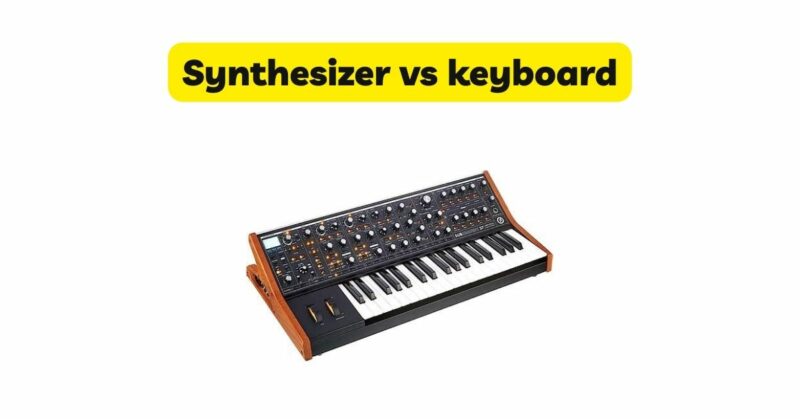In the world of electronic music, the terms “synthesizer” and “keyboard” are often used interchangeably, leading to confusion about their true differences. While they share similarities in appearance and function, synthesizers and keyboards have distinct characteristics that set them apart. In this article, we will explore the nuanced differences between synthesizers and keyboards, including their functionality, sound generation capabilities, control options, and intended use cases. By understanding these distinctions, musicians can make informed decisions when choosing between a synthesizer and a keyboard for their musical needs.
- Sound Generation: One of the primary distinctions between synthesizers and keyboards lies in their sound generation capabilities. A keyboard is typically an electronic instrument that emulates the sounds of traditional acoustic instruments such as pianos, organs, and orchestral instruments. Keyboards often use digital sampling or physical modeling to reproduce realistic instrument sounds.
On the other hand, a synthesizer is designed to create and manipulate sound through electronic signal processing. Synthesizers generate sound using oscillators, filters, envelopes, and modulation sources. They offer a wide range of sonic possibilities, including creating unique sounds, manipulating existing sounds, and generating electronic textures. Synthesizers are known for their versatility and ability to create sounds that go beyond traditional instrument replication.
- Control Options: Another distinction between synthesizers and keyboards is the range of control options they offer. Keyboards are typically designed with a focus on performance and playability. They feature standard piano-style keys and a range of performance-oriented controls such as pitch bend wheels, modulation wheels, and sustain pedals. Keyboards prioritize ease of use and accessibility, providing musicians with a familiar playing experience.
In contrast, synthesizers provide a greater degree of control and customization. They often include a variety of knobs, sliders, buttons, and touch-sensitive surfaces that allow for real-time manipulation of sound parameters. Synthesizers offer extensive modulation options, allowing musicians to shape and sculpt sound to their liking. This flexibility makes synthesizers popular among electronic music producers and sound designers who require precise control over sound creation and manipulation.
- Design and Form Factor: In terms of design and form factor, keyboards and synthesizers can have similar appearances, but there are differences worth noting. Keyboards are typically designed to resemble traditional pianos, with a horizontal layout of keys and a more compact and portable form factor. They are often lightweight and portable, making them suitable for stage performances or on-the-go musicians.
Synthesizers, on the other hand, come in a variety of shapes and sizes. They can range from compact tabletop units to larger, full-sized keyboard synthesizers. Synthesizer designs often prioritize functionality and sound creation capabilities over portability. Some synthesizers are modular, allowing for the expansion and customization of sound modules and control options. The design and form factor of synthesizers can cater to specific genres, production environments, or individual preferences.
- Intended Use Cases: The intended use cases for keyboards and synthesizers also contribute to their distinctions. Keyboards are commonly used in various musical settings, including live performances, studio recordings, and educational settings. They provide a versatile and accessible option for playing traditional piano sounds and other instrument emulations.
Synthesizers, on the other hand, are favored by musicians and producers looking to explore electronic music genres, sound design, and experimental sonic landscapes. Synthesizers offer the creative freedom to craft unique sounds, experiment with different synthesis techniques, and push the boundaries of traditional musical conventions. They are widely used in electronic music production, film scoring, and live performances where sonic exploration and innovation are paramount.
- Price Range: Price is another aspect to consider when comparing synthesizers and keyboards. Keyboards, particularly entry-level models, tend to be more affordable, making them accessible to a wide range of musicians and beginners. Higher-end professional keyboards can be more expensive, especially when featuring advanced features, premium sound libraries, and high-quality construction.
Synthesizers, on the other hand, can vary significantly in price depending on their complexity, features, and sound generation capabilities. While there are affordable synthesizer options available, many professional-grade synthesizers with extensive control options and advanced synthesis techniques can be more expensive. The cost of synthesizers often reflects the depth of sound manipulation and customization they offer.
Conclusion: While synthesizers and keyboards may appear similar at first glance, they have distinct characteristics that set them apart. Keyboards focus on emulating traditional instrument sounds and prioritize playability and performance. They are versatile instruments suitable for various musical genres and settings. Synthesizers, on the other hand, provide extensive sound manipulation capabilities, offering a wide range of unique and customizable sounds. They are favored by electronic music producers and sound designers for their sonic versatility and creative potential.
Choosing between a synthesizer and a keyboard depends on individual musical preferences, creative goals, and intended use cases. Keyboards are ideal for those seeking realistic instrument sounds and a traditional playing experience, while synthesizers cater to those seeking sonic exploration, sound design possibilities, and electronic music production. Ultimately, the decision between a synthesizer and a keyboard rests on the specific needs and musical aspirations of each individual musician.

